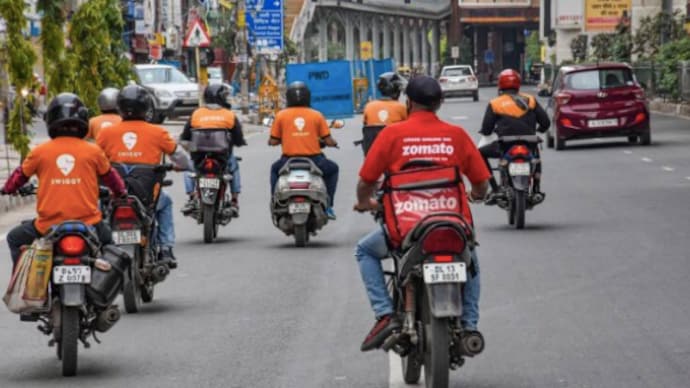Online food delivery services may attract GST soon. Check details
Online food delivery services through apps could soon attract GST. A meeting of the GST Council on Friday will decide whether app-based food delivery services will attract additional GST.

There could be bad news for individuals who frequently order from online food delivery platforms like Zomato and Swiggy. Food delivery services offered by app-based e-commerce operators (ECOs) may soon attract Goods and Services Tax (GST).
At the upcoming GST Council meeting to be held on September 17, a proposal to levy GST on restaurant delivery services offered by ECOs such as Swiggy and Zomato will be discussed.
The suggestion has been made by the Fitment Committee of the GST Council. The committee has proposed that it should be clarified by way of a circular that serving of food, door delivery and takeaway by cloud kitchens/central kitchens are covered under “restaurant service.
Read | GST Council may discuss proposal to include diesel, petrol on Friday
The committee has proposed two options.
TWO PROPOSALS FOR GST ON FOOD DELIVERY APPS
The first one involves notifying ECOs as “deemed suppliers” under two categories — from the restaurant to ECO with a tax rate of 5 per cent without input credit and 18 per cent with input credit — and from ECO to the customer attracting 5 per cent with limited Input Tax Credit.
The second proposal is to notify the ECOs as aggregators and fixing the rate later. With this move, ECOs would have to pay GST for all supplies made for restaurant service.
However, to tackle the problem — this may not apply to the restaurants in hotels with tariffs higher than Rs 7,500 — there is a proposal for a separate return with GSTIN-based details of tax being collected and paid by ECOs to be declared.
Since there is a Rs 20 lakh base limit for service providers to get registered, the proposal is to include all restaurant services under the category of ‘Aggregator’ and ECOs as aggregators of delivery services.
Sources said that once cleared by the GST Council, the operators may get a three-month window to make all the requisite changes to their software.
COMPLEX FOOD BUSINESS
Interestingly, the committee observed that there are no specified legal criteria to identify as to what would qualify as a restaurant or eating joint.
It states that the word “restaurant service is defined as (vide Notification No.11/2017 — CTR as amended by Notification No. 20/2019-CTR dated 30.09.2019) as supply, by way of or as part of any service, of goods, being food or any other article for human consumption or any drink, provided by a restaurant, eating joint including mess, canteen, whether for consumption on or away from the premises where such food or any other article for human consumption or drink is supplied.
As per the definition, the committee said restaurant service, eating joints including mess and canteen and service providers are categorised under 'restaurant' category, while Cloud kitchen are typically delivery only models without eating joint.
However, some cloud kitchen models may provide for eating facility to a customer.
On the other hand, the classification of service states that “restaurant service includes services provided by restaurants, cafés and similar eating facilities including takeaway services, room services and home delivery of food.
Before making the recommendations, the committee went through an E-Commerce Sectoral Study of Suppliers dealing in food delivery.
Sources in the government said that apps like Zomato are registered as tax collectors at source (TCS) and they do not carry out mandatory GST registration checks on restaurants that are not part of the GST system but are part of their supply chain.
Food delivery is a now thriving business as per the govt’s assessment and the GST Council estimates a revenue loss in the segment to the tune of Rs 2,000 crore. Tax analysis teams have been studying the possible gap between the taxable turnover provided by Swiggy and Zomato compared to that provided by the food supplier.
